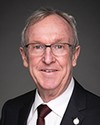You're right. There's over 50 years of historical data in approximately 100 banker boxes. This data is owned by the individuals who were tested. This personal medical information has been released to the individuals who were tested. If you have an individual who, for example, was born to a mother whose cord blood was tested at the time of birth, the cord blood data was released to the mother.
Throughout the past 50 years, we've had ongoing requests from community members to get access to their personal medical information. I've been in the position for about two years, and I've had 40 or 50 individuals who have asked for their personal medical information. That information has been released upon request to the individual, or, depending on how they sign the consent, to the person with whom they want to share the information, such as a researcher or a physician. It is an individual's personal medical information.
That said, since, I think, the mid-1970s, upon request by researchers who had the support of the community, we have been releasing this data, and this data has been going to the researchers in a de-identifiable format. That means it doesn't have a date of birth or a name. You cannot identify who the individual is, but we have been releasing that data when requested.
We need to make sure that we protect individuals' personal medical information, and we have to respect the Privacy Act. If we released data without the appropriate measures in place, we'd be not in keeping with the Privacy Act.





